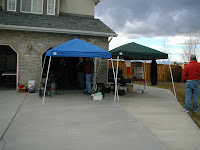
by Keith Fisher
On a previous blog, I promised I would talk about chuck boxes, but I’ve been getting sidetracked with other, more exciting subjects. Since the weather is turning and with it, thoughts of getting our equipment into shape for the big Deer hunt. I think I’ll get back to it.
When I was a kid growing up in Utah, it was fairly easy to get a license and go hunting. Most of the hunting population didn’t even make plans about where they were going to hunt until the end of September. We usually got together and listened to the scouting reports from one or two who had gone on the archery, or some other, earlier hunt. From the report, we decided where we would go and usually opted for the customary place.
We had a special canyon we hunted every year. We knew all the names and the geography. It felt good to know some things never changed. Then the DWR rewrote the rules.
Now we have to submit to a drawing, choose which hunt we are going to hunt, and which area we plan to go, all before the end of January each year. If I choose to hunt on the archery hunt, I’m done and can’t hunt deer any more that year. I must decide in the winter before, which hunt will be most successful and which area will have the most deer. Unless I want to hunt alone, I must pick the same area my family chooses.
With all the hoops we have to jump through, it’s not hard to visualize what happened this year. I went online on the last day to register, one hour after the deadline. All my other family members have similar stories, and needless to say, We’re going fishing on the deer hunt opening. But I digress, I promised I’d talk about Chuck boxes.
Everyone has some sort of container for the tools it takes to cook and clean up in the outdoors. I started with a storage tub and bucket. Everything went downhill after that.
 In many cook offs, people were judged for their equipment, so I wanted something that looked the part of the old west, but was still functional as a transportation box. I ended up building the refrigerator size Chuck box I used to store Dutch ovens in. It’s not only as big as a refrigerator, it’s heavy too. I soon wore out and began to think about other ways.
In many cook offs, people were judged for their equipment, so I wanted something that looked the part of the old west, but was still functional as a transportation box. I ended up building the refrigerator size Chuck box I used to store Dutch ovens in. It’s not only as big as a refrigerator, it’s heavy too. I soon wore out and began to think about other ways.
My next camp kitchen was designed to be like an old chuck wagon box and I used thin plywood and light materials. Being four feet wide. It was awkward to carry and became a burden to move for one person. At this time I also designed a pot box, or Dutch oven storage box. It was the perfect size to place two washtubs on top, next two the end of a banquet table. We washed dishes while sitting in a camp chair. Carrying even that was a two-man job.
perfect size to place two washtubs on top, next two the end of a banquet table. We washed dishes while sitting in a camp chair. Carrying even that was a two-man job.
 perfect size to place two washtubs on top, next two the end of a banquet table. We washed dishes while sitting in a camp chair. Carrying even that was a two-man job.
perfect size to place two washtubs on top, next two the end of a banquet table. We washed dishes while sitting in a camp chair. Carrying even that was a two-man job.At that time, I noticed a set of clear plastic drawer cabinets on sale and got an idea. I had never seen anyone use those for a camp kitchen, and although I can’t prove it, I think I was the first to use one. Now if you go to cook offs, you may see many of them.
camp kitchen, and although I can’t prove it, I think I was the first to use one. Now if you go to cook offs, you may see many of them.
 camp kitchen, and although I can’t prove it, I think I was the first to use one. Now if you go to cook offs, you may see many of them.
camp kitchen, and although I can’t prove it, I think I was the first to use one. Now if you go to cook offs, you may see many of them.The Refrigerator sized box now stores Dutch ovens and collects dust in my carport. (It has to. Who would move it?). The wide box remains in my back yard. I use it to cook in the back yard. The plastic drawer cabinet sits in my dining room. We keep it filled with all the tools we need to cook in camp. One person can put it in the back of the truck and it sits easily on a picknic table.
Whatever you use, it should be easy to carry and simple to use. It should hold all the tools you will need to be successful, and don’t forget to stock it with toothpicks.






